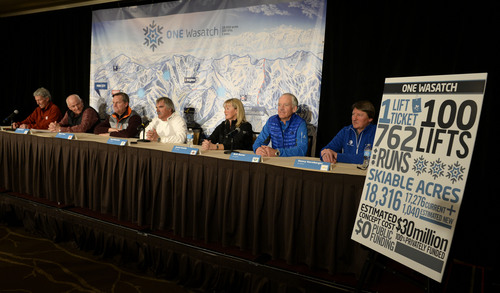This is an archived article that was published on sltrib.com in 2014, and information in the article may be outdated. It is provided only for personal research purposes and may not be reprinted.
Wednesday's unveiling of One Wasatch, the Utah ski industry's idea for linking resorts in Salt Lake and Summit counties, was noteworthy in several respects.
• It marked the most concerted effort to date by Utah's ski industry to actually pursue the long-discussed, long-disputed concept of interconnecting the seven resorts clustered tightly in the heart of the Wasatch Mountains.
• It brought together for the first time in memory the general managers of the seven independent resorts, symbolic of their solidarity in supporting the still nebulous concept.
• Although industry officials offered multiple assurances that they will do all they can to protect watersheds and the interests of backcountry skiers, the pledges did nothing to lessen the opposition of Save Our Canyons or the Wasatch Backcountry Alliance.
"It's a concept we're definitely not excited about, whatsoever," said Save Our Canyons Executive Director Carl Fisher.
"It doesn't change how I feel about it at all," added Wasatch Backcountry Alliance President Jamie Kent. "I have no confidence they can protect the backcountry."
Ski Utah President Nathan Rafferty said he knew the concept would get plenty of feedback, negative included. But he added that the seven general managers, who have 289 years of cumulative ski industry experience, understand the importance of feedback in shaping still-forming plans.
There are unresolved issues, Rafferty acknowledged.
For instance, he couldn't identify specific lift alignments, other than to say they would make three key connections:
• Little Cottonwood Canyon to Big Cottonwood.
• Big Cottonwood to Park City Mountain Resort.
• PCMR to Canyons Resort.
A fourth and lesser link, between Park City and Deer Valley, only entails taking down a rope that marks those resorts' common boundary.
Rafferty could say the total cost is projected to be about $30 million, all privately financed, all on private lands.
But he could not say when work on the project would begin or what kind of timetable industry officials had in mind for completion.
Still, he added, "connecting seven of Utah's finest ski resorts while preserving both our water quality and a pristine backcountry experience is not an impossible task."
If enacted as envisioned now, Rafferty said, Utah skiing would establish a niche for itself unique in North America. Customers would be able to buy one pass (price still unknown) that would provide access to "seven distinct resort personalities," 18,000 skiable acres, 100 lifts and more than 750 runs.
"With this concept coming to life, there's not a ski area or community in this country that can beat us," said PCMR General Manager Jenni Smith.
"It will be an opportunity to create a ski experience rivaled only by the large ski circuits in Europe," added Canyons GM Mike Goar.
The concept undoubtedly has more appeal for destination visitors than locals, Rafferty admitted, while insisting different types of ticketing packages could be devised easily to pique the interest of Utah's ski community.
But there's growing interest, he contended, in a type of European mountain culture where someone might start at Snowbird, take lifts and runs to Deer Valley for lunch and then return in the afternoon.
"We'll bring a slice of that here," Rafferty said.
Alta GM Onno Wieringa said industry officials have been prodded by a series of Utah governors to interconnect the resorts, but conditions were never right.
Quipped Utah ski historian Mike Korologos: "You couldn't get resort operators to talk to each other at a cocktail party in the [old] days, let alone agree on a master concept."
Times have changed, Wieringa noted, adding "we always said [interconnect] will happen when it makes sense between the ski areas."
It does now, agreed Brighton's Randy Doyle. "Get this thing done," he said, and give visitors a chance to "savor the flavor of each resort. It will just be a dang lot of fun."
But it's not in the eyes of the many conservationists and backcountry skiers who are dead set against resort expansion and see this as just another way for the ski areas to extend their reach over the central Wasatch Front.
"One Horrible Plan for the Wasatch Mountains" is how Fisher headlined his epistle against the concept on the Save Our Canyons website, encouraging people to sign a petition against One Wasatch.
He dismissed assurances of environmental sensitivity as a "talking point" that ignores the reality that "any time you build a lift or anything in the watershed there are impacts."
Fisher also concurred with the Backcountry Alliance's Kent that compromises were made years ago giving the resorts the best ski terrain in the mountaintops, and that conservationists and backcountry skiers are simply trying to hold onto terrain that is rightfully theirs.
"Our members believe the current balance between opportunities for resort and backcountry skiing is a crucial component of Utah's attraction as a winter-recreation mecca and that this balance must be protected," Kent said in a prepared statement.
He also released a letter sent last Thursday to Gov. Gary Herbert by almost 200 Outdoor Retailer trade show participants, asking Herbert to ensure that interconnect plans be considered as part of a larger study, such as the Mountain Accord, which is analyzing the future of the central Wasatch Front.
Rafferty said the ski industry is fully committed to the Mountain Accord process and released the One Wasatch concept now so it could be part of that evaluation.
Twitter: @sltribmikeg —
Interconnect website
To learn more about the One Wasatch interconnect concept, go to onewasatch.com.





